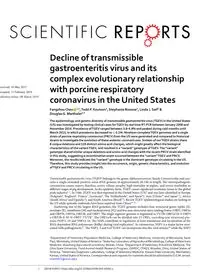
2019 Decline of transmissible gastroenteritis virus and its complex evolutionary relationship with porcine respiratory c PDF
Preview 2019 Decline of transmissible gastroenteritis virus and its complex evolutionary relationship with porcine respiratory c
1 Scientific RepoRts | (2019) 9:3953 | https://doi.org/10.1038/s41598-019-40564-z www.nature.com/scientificreports Decline of transmissible gastroenteritis virus and its complex evolutionary relationship with porcine respiratory coronavirus in the United states Fangzhou Chen 1,2, Todd P. Knutson1, Stephanie Rossow1, Linda J. saif3 & Douglas G. Marthaler1,4 the epidemiology and genetic diversity of transmissible gastroenteritis virus (tGeV) in the United states (US) was investigated by testing clinical cases for TGEV by real time RT-PCR between January 2008 and November 2016. Prevalence of TGEV ranged between 3.8–6.8% and peaked during cold months until March 2013, in which prevalence decreased to < 0.1%. Nineteen complete TGEV genomes and a single strain of porcine respiratory coronavirus (pRCV) from the Us were generated and compared to historical strains to investigate the evolution of these endemic coronaviruses. Sixteen of our TGEV strains share 8 unique deletions and 119 distinct amino acid changes, which might greatly affect the biological characteristics of the variant TGEV, and resulted in a “variant” genotype of TGEV. The “variant” genotype shared similar unique deletions and amino acid changes with the recent PRCV strain identified in this study, suggesting a recombination event occurred between the ‘‘variant’’ TGEV and PRCV. Moreover, the results indicate the “variant” genotype is the dominant genotype circulating in the US. Therefore, this study provides insight into the occurrence, origin, genetic characteristics, and evolution of TGEV and PRCV circulating in the US. Transmissible gastroenteritis virus (TGEV) belongs to the genus Alphacoronavirus, family Coronaviridae and con- tains a single-stranded, positive-sense RNA genome of approximately 28.5 kb in length. The enteropathogenic coronavirus causes watery diarrhea, severe villous atrophy, high mortality in piglets, and severe morbidity in different stages of pig development. In the epidemic form, TGEV causes significant economic losses to the global pork industry1–4. In 1946, TGEV was first reported in the United States (US)5 and was later identified in Europe (Belgium6, England2, France7, Germany8, The Netherlands6, and Spain9), Asia (China10 and Japan11), Africa (South Africa4 and Uganda12), and South America (Brazil13). Recent TGEV epidemiological studies are lacking in the US while sporadic outbreaks have been reported from China14–16. Harboring one of the largest RNA genomes, the TGEV genome includes four structural genes (spike [S], envelope [E], membrane [M] and nucleoprotein [N]) and five non-structural open reading frame (ORF): ORF1a and ORF1b, ORF3a, ORF3b, and ORF7. The single segment genome is organized as 5′UTR-ORF1a/1b-S-ORF3 a-ORF3b-E-M-N-ORF7-3′UTR3. The ORF1a/b can be divided into 15 ORFs, encoding non-structural pro- teins (NSP)1-10 and NSP12-16. The NSPs contribute to regulation of host translation and localization of the RNA-dependent RNA polymerase (RdRp) during viral replication3. In coronavirus, NSP1 is a major factor asso- ciated with pathogenicity17. The NSP2, 3 and 8 of TGEV can incorporate into the viral articles18 while the NSP3 1Department of Veterinary Population Medicine, college of Veterinary Medicine, University of Minnesota, Saint Paul, Minnesota, United States of America. 2State Key Laboratory of Agricultural Microbiology, college of Veterinary Medicine, Huazhong Agricultural University, Wuhan, China. 3Department of Veterinary Preventive Medicine, the Ohio State University, Food Animal Health Research Program, OARDC, CFAES, Wooster, Ohio, United States of America. 4Veterinary Diagnostic Laboratory, college of Veterinary Medicine, Kansas State University, Manhattan, Kansas, United States of America. correspondence and requests for materials should be addressed to D.G.M. (email:
